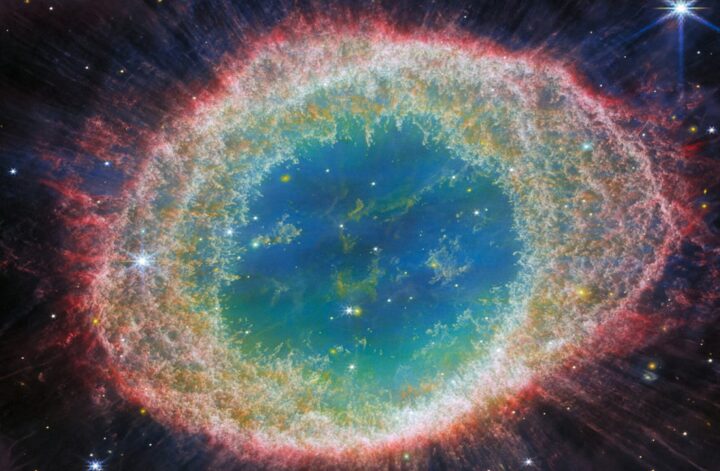The James Webb Space Telescope has captured a stunningly detailed image of the Ring Nebula that forshadows the eventual fate of our Sun, which will likely create a similar spectacle following its transition into a red giant in five billion years time.
Located roughly 2,600 light years from Earth in the constellation Lyra is the colourful cosmic eye of the Ring Nebula. The structure was created when a red giant star, which was nearing the end of its life, cast off vast quantities of stellar material into the surrounding space environment. Radiation from the star then saturated the material, which in turn ionised it, causing the retreating mass to shine with its own soft light.
“The nebula is growing larger,” University of Manchester professor of astrophysics Albert Zijlstra told IGN. “Eventually, it will dissolve into the galaxy. Over time, the gas and dust can find its way into areas where new stars form, and become part of new stars and planets. We know that happened to us, when the solar system formed, it incorporated fragments of older planetary nebulae.”
The one ring that rules them all has been observed by #NASAWebb!
The remains of a dying Sun-like star, the Ring Nebula has given astronomers valuable insights into the formation and evolution of planetary nebulas: https://t.co/dRSQAriIDH pic.twitter.com/zkYswl5phc
— Space Telescope Science Institute (@SpaceTelescope) August 21, 2023
The incredible spatial resolution of the new Webb image allowed scientists to identify a number of previously unknown features in the nebula’s structure, which hinted that the vast cloud of dust and gas was being shaped by the influence of not one, but three stellar bodies.
“These telescope and infrared detection innovations mean many of the Ring’s details revealed in these latest JWST images were not previously visible to astronomers,” said Dr Mikako Matsuura, a reader at Cardiff University’s School of Physics and Astronomy, who was one of the scientists involved with the new observations.
“Where before we saw only a ring, we now know it is filled with 20,000 globules. And, for the first time, we can also see beyond the ring which extends with faint spikes and arcs, shaping a petal-like structure resembling a flower.”
The astronomers believe that the ten concentric arcs spotted in the outer ring were created by the gravitational influence of a relatively small companion star as it orbits the red giant at the heart of the nebula with a separation similar to the distance that separates the Sun and Pluto. As the companion swept around the star, it would have shaped the outflow of escaping material, creating roughly one arc every 280 years.
A few thousand years from now, the nebula’s brilliance will begin to fade as the central red dwarf cools, and transitions into a white dwarf — the dense core of a dead star. Billions of years after that, the Sun will likely follow in the footsteps of its distant stellar relative to form a nebula of its own.
“The Sun is a bit smaller than the star which created the Ring Nebula. It can form such a planetary nebula, in about five billion years, but it is at the limit: [if] it were only a few percent smaller, it would not manage,” said Zijlstra to IGN. “It will form a nebula that is fainter and less colourful than the Ring nebula, and as the Sun does not have a companion star, will probably form a round nebula.”
Anthony is a freelance contributor covering science and video gaming news for IGN. He has over eight years experience of covering breaking developments in multiple scientific fields and absolutely no time for your shenanigans. Follow him on Twitter @BeardConGamer
Image credit: Credit: ESA/Webb, NASA, CSA, M. Barlow (University College London), N. Cox (ACRI-ST), R. Wesson (Cardiff University)
